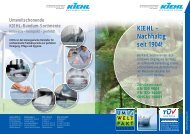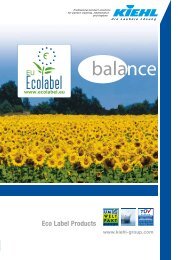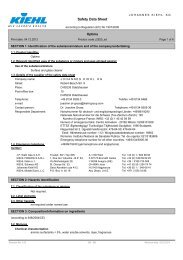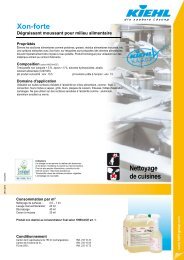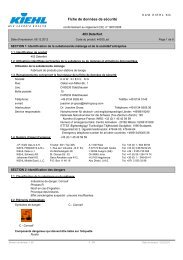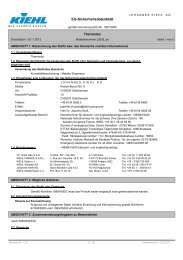Safety Data Sheet - Kiehl-group.com
Safety Data Sheet - Kiehl-group.com
Safety Data Sheet - Kiehl-group.com
You also want an ePaper? Increase the reach of your titles
YUMPU automatically turns print PDFs into web optimized ePapers that Google loves.
<strong>Safety</strong> <strong>Data</strong> <strong>Sheet</strong><br />
J O H A N N E S K I E H L<br />
K G<br />
according to Regulation (EC) No 1907/2006<br />
Hodrupa A<br />
Print date: 04.12.2012 Product code: j0501_sd<br />
Page 1 of 7<br />
SECTION 1: Identification of the substance/mixture and of the <strong>com</strong>pany/undertaking<br />
1.1. Product identifier<br />
Hodrupa A<br />
1.2. Relevant identified uses of the substance or mixture and uses advised against<br />
Use of the substance/mixture<br />
High pressure and engine cleaner with corrosion prevention<br />
1.3. Details of the supplier of the safety data sheet<br />
Company name:<br />
Street:<br />
Place:<br />
Post-office box:<br />
J O H A N N E S K I E H L<br />
Robert-Bosch-Str. 9<br />
D-85235 Odelzhausen<br />
15<br />
D-85233 Odelzhausen<br />
Telephone: +49 8134 9305.0 Telefax:+49 8134 6466<br />
e-mail:<br />
K G<br />
joachim.dr-gross@kiehl-<strong>group</strong>.<strong>com</strong><br />
Contact person: Dr. Joachim Gross<br />
Telephone: +49 8134 9305-36<br />
Responsible Department:<br />
1.4. Emergency telephone<br />
number:<br />
Notrufnummer für deutsch- und englischsprachige Länder: +49/89/19240<br />
Nationale Notrufnummer für die Schweiz (Tox-Zentrum Zürich): 145<br />
Numéro d'urgence France: INRS: +33 (0) 1 45 42 59 59<br />
Numero d' emergenza Italia: Centro Antiveleni - 20162 Milano: 02/66101029<br />
ETTSZ /Egészségügyi Toxikológiai Tájékoztató Szolgálat/, 1096 Budapest,<br />
Nagyvárad tér 2. Ügyeleti telefonszám: 476-64-00, 476-64-64<br />
Eesti: Häirekeskuse number: 112 / Mürgistusteabekeskuse number: 16662<br />
Romania: Institutul National de Sanatate Publica: Tel. de urgenta: 021/3183606<br />
Emergency telephone number for all other countries: +49/8134/9305-36<br />
+49/89/19240 (germanophone and anglophone)<br />
J.P. <strong>Kiehl</strong> Ges.m.b.H. Troststr. 50/1 Top 305; A-1100 Wien Tel. +43 (0) 1 / 604 99 93<br />
KIEHL FRANCE S.A.R.L. 1, Rue de l´industrie - B.P. 54; F-67172 Brumath Cedex Tél. +33 (0) 3.88.59.52.25<br />
KIEHL Italia s.r.l. Via Michelangelo 29; I-16036 Avegno (GE) Tel. +39 / 0185 730 008<br />
KIEHL Schweiz AG St. Dionys-Str. 33; CH-8645 Jona Tel. +41 (0) 55 / 254 74 74<br />
Johannes <strong>Kiehl</strong> KG Ganz Ábrahám ucta 4/12, H-2142 Nagytarcsa Tel. +36 (0) 1 / 348-08 41<br />
KIEHL Middle East L.L.C. P.O. Box 11 40 19 Abu Dhabi, U.A.E. Tel. +971 2 550 33 96<br />
SECTION 2: Hazards identification<br />
2.1. Classification of the substance or mixture<br />
2.2. Label elements<br />
Indications of danger: Irritant<br />
R phrases:<br />
Irritating to eyes and skin.<br />
Danger symbols:<br />
Xi - Irritant<br />
Xi - Irritant<br />
Hazardous <strong>com</strong>ponents which must be listed on the label<br />
Alkali lyes<br />
Revision No: 1,06 GB - EN<br />
Revision date: 18.02.2011
<strong>Safety</strong> <strong>Data</strong> <strong>Sheet</strong><br />
J O H A N N E S K I E H L<br />
K G<br />
according to Regulation (EC) No 1907/2006<br />
Hodrupa A<br />
Print date: 04.12.2012 Product code: j0501_sd<br />
Page 2 of 7<br />
R phrases<br />
36/38 Irritating to eyes and skin.<br />
S phrases<br />
24/25 Avoid contact with skin and eyes.<br />
37/39 Wear suitable gloves and eye/face protection.<br />
SECTION 3: Composition/information on ingredients<br />
(according to 648/2004/CE)<br />
3.2. Mixtures<br />
Chemical characterization<br />
anionic surfactants < 5%, nonionic surfactants < 5%, NTA < 5%, water soluble solvents, alkalis,<br />
corrosion protection<br />
Hazardous <strong>com</strong>ponents<br />
EC No<br />
CAS No<br />
Index No<br />
REACH No<br />
225-768-6<br />
5064-31-3<br />
215-199-1<br />
1312-76-1<br />
203-905-0<br />
111-76-2<br />
603-014-00-0<br />
286-316-1<br />
85204-21-3<br />
Chemical name<br />
Classification<br />
GHS classification<br />
Trisodiumnitrilotriacetate<br />
Carc. Cat. 3, Xn - Harmful, Xi - Irritant R22-36-40<br />
Met. Corr. 1, Eye Irrit. 2, Carc. 2; H290 H319 H351<br />
Potassium silicate<br />
C - Corrosive R34<br />
Skin Corr. 1B; H314<br />
2-butoxyethanol, butyl cellosolve, ethylene glycol monobutyl ether<br />
Xn - Harmful, Xi - Irritant R20/21/22-36/38<br />
Acute Tox. 4, Acute Tox. 4, Acute Tox. 4, Eye Irrit. 2, Skin Irrit. 2; H332 H312 H302<br />
H319 H315<br />
Dicarboxylic acid monoalkylamide, triethanolamine<br />
Xi - Irritant R43<br />
Eye Dam. 1, Skin Sens. 1; H318 H317<br />
Quantity<br />
1 - 5 %<br />
1 - 5 %<br />
1 - 5 %<br />
1 - 5 %<br />
215-181-3<br />
caustic potash, potassium hydroxide<br />
1310-58-3<br />
C - Corrosive, Xn - Harmful R22-35<br />
019-002-00-8<br />
Acute Tox. 4, Skin Corr. 1A; H302 H314<br />
Full text of R and H phrases: see Section 16.<br />
< 1 %<br />
SECTION 4: First aid measures<br />
4.1. Description of first aid measures<br />
General information<br />
Avoid contact with skin and eyes.<br />
After inhalation<br />
not hazardous by inhalation<br />
After contact with skin<br />
Wash off immediately with soap and plenty of water while removing all contaminated clothes and<br />
shoes.<br />
After contact with eyes<br />
Rinse thoroughly with plenty of water, also under the eyelids. If eye irritation persists, consult a<br />
Revision No: 1,06 GB - EN<br />
Revision date: 18.02.2011
<strong>Safety</strong> <strong>Data</strong> <strong>Sheet</strong><br />
J O H A N N E S K I E H L<br />
K G<br />
according to Regulation (EC) No 1907/2006<br />
Hodrupa A<br />
Print date: 04.12.2012 Product code: j0501_sd<br />
Page 3 of 7<br />
specialist.<br />
After ingestion<br />
Drink plenty of water. Do NOT induce vomiting.<br />
If swallowed, seek medical advice immediately and show this container or label.<br />
4.2. Most important symptoms and effects, both acute and delayed<br />
This information is not available.<br />
4.3. Indication of any immediate medical attention and special treatment needed<br />
Show this safety data sheet to the doctor in attendance.<br />
SECTION 5: Firefighting measures<br />
5.1. Extinguishing media<br />
Suitable extinguishing media<br />
Any extinguishing means and measures are acceptable.<br />
5.2. Special hazards arising from the substance or mixture<br />
This information is not available.<br />
5.3. Advice for firefighters<br />
Use extinguishing measures that are appropriate to local circumstances and the surrounding<br />
environment. The product itself does not burn.<br />
SECTION 6: Accidental release measures<br />
6.1. Personal precautions, protective equipment and emergency procedures<br />
Avoid contact with skin and eyes.<br />
6.2. Environmental precautions<br />
Do not flush into surface water.<br />
6.3. Methods and material for containment and cleaning up<br />
Wipe up with absorbent material (e.g. cloth, fleece). After cleaning, flush away traces with water.<br />
Never return spills in original containers for re-use.<br />
6.4. Reference to other sections<br />
Never return spills in original containers for re-use.<br />
SECTION 7: Handling and storage<br />
7.1. Precautions for safe handling<br />
Advice on safe handling<br />
Avoid contact with skin and eyes.<br />
Advice on protection against fire and explosion<br />
Not required<br />
7.2. Conditions for safe storage, including any in<strong>com</strong>patibilities<br />
Requirements for storage rooms and vessels<br />
Store at room temperature in the original container. Store in a place accessible by authorized persons<br />
only.<br />
Advice on storage <strong>com</strong>patibility<br />
Keep away from food, drink and animal feedingstuffs.<br />
Do not store near acids.<br />
Further information on storage conditions<br />
Keep container tightly closed.<br />
Never return unused material to storage receptacle.<br />
7.3. Specific end use(s)<br />
This information is not available.<br />
Revision No: 1,06 GB - EN<br />
Revision date: 18.02.2011
<strong>Safety</strong> <strong>Data</strong> <strong>Sheet</strong><br />
J O H A N N E S K I E H L<br />
K G<br />
according to Regulation (EC) No 1907/2006<br />
Hodrupa A<br />
Print date: 04.12.2012 Product code: j0501_sd<br />
Page 4 of 7<br />
SECTION 8: Exposure controls/personal protection<br />
8.1. Control parameters<br />
Exposure limits (EH40)<br />
CAS No<br />
Substance<br />
ppm<br />
mg/m³<br />
fibres/ml<br />
Category<br />
Origin<br />
111-76-2 2-Butoxyethanol<br />
25 123 TWA (8 h) WEL<br />
50 246 STEL (15 min) WEL<br />
1310-58-3 Potassium hydroxide<br />
-<br />
- TWA (8 h) WEL<br />
Biological Monitoring Guidance Values (EH40)<br />
- 2 STEL (15 min) WEL<br />
CAS No<br />
Substance<br />
Parameter Value Test material<br />
Sampling time<br />
111-76-2 2-Butoxyethanol butoxyacetic acid<br />
240 urine<br />
mmol/mol<br />
Post shift<br />
Additional advice on limit values<br />
8.2. Exposure controls<br />
If applied according to regulations, this will fall below the limit. There is no risk to health.<br />
Occupational exposure controls<br />
Not required<br />
Protective and hygiene measures<br />
Handle in accordance with good industrial hygiene and safety practice.<br />
Hand protection<br />
Protective gloves<br />
Re<strong>com</strong>mendation: Nitrile gloves with a coating thickness of 0.4 mm which protect at least 8 hours<br />
(corresponds to the permeability level 6 of the European norm DIN/EN 374) and provide a resistance to<br />
swelling of < 15%.<br />
Eye protection<br />
<strong>Safety</strong> glasses with side-shields.<br />
SECTION 9: Physical and chemical properties<br />
9.1. Information on basic physical and chemical properties<br />
Physical state:<br />
Colour:<br />
Odour:<br />
liquid<br />
light brown<br />
characteristic<br />
Test method<br />
pH-Value (at 20 °C): 13 K-QP1012C<br />
Changes in the physical state<br />
Melting point:<br />
Boiling point:<br />
Sublimation point:<br />
Softening point:<br />
Flash point:<br />
Flammability<br />
Solid:<br />
98 °C<br />
not applicable<br />
not applicable<br />
>100 °C<br />
not applicable<br />
Revision No: 1,06 GB - EN<br />
Revision date: 18.02.2011
<strong>Safety</strong> <strong>Data</strong> <strong>Sheet</strong><br />
J O H A N N E S K I E H L<br />
K G<br />
according to Regulation (EC) No 1907/2006<br />
Hodrupa A<br />
Print date: 04.12.2012 Product code: j0501_sd<br />
Page 5 of 7<br />
Gas:<br />
Lower explosion limits:<br />
Upper explosion limits:<br />
Ignition temperature:<br />
Auto-ignition temperature<br />
Solid:<br />
Gas:<br />
Vapour pressure:<br />
not applicable<br />
not applicable<br />
not applicable<br />
>300 °C<br />
not applicable<br />
not applicable<br />
not determined<br />
Density (at 20 °C): 1,15 g/cm³ K-QP1012E<br />
Water solubility:<br />
<strong>com</strong>pletely miscible<br />
(at 20 °C)<br />
Solubility in other solvents<br />
not determined<br />
Partition coefficient:<br />
Viscosity / dynamic:<br />
Viscosity / kinematic:<br />
Vapour density:<br />
Evaporation rate:<br />
9.2. Other information<br />
Solid content:<br />
not determined<br />
not determined<br />
not determined<br />
not determined<br />
not determined<br />
not determined<br />
SECTION 10: Stability and reactivity<br />
10.1. Reactivity<br />
This information is not available.<br />
10.2. Chemical stability<br />
This information is not available.<br />
10.3. Possibility of hazardous reactions<br />
This information is not available.<br />
10.4. Conditions to avoid<br />
Do not expose to temperatures above 35 °C.<br />
10.5. In<strong>com</strong>patible materials<br />
This information is not available.<br />
10.6. Hazardous de<strong>com</strong>position products<br />
No de<strong>com</strong>position if stored and applied as directed.<br />
Further information<br />
Do not mix with other detergents or chemicals.<br />
SECTION 11: Toxicological information<br />
11.1. Information on toxicological effects<br />
Revision No: 1,06 GB - EN<br />
Revision date: 18.02.2011
<strong>Safety</strong> <strong>Data</strong> <strong>Sheet</strong><br />
J O H A N N E S K I E H L<br />
K G<br />
according to Regulation (EC) No 1907/2006<br />
Hodrupa A<br />
Print date: 04.12.2012 Product code: j0501_sd<br />
Page 6 of 7<br />
Acute toxicity<br />
CAS No<br />
Chemical name<br />
Exposure routes<br />
Method<br />
Dose<br />
111-76-2 2-butoxyethanol, butyl cellosolve, ethylene glycol monobutyl ether<br />
oral<br />
dermal<br />
LD50<br />
ATE<br />
1746 mg/kg<br />
1100 mg/kg<br />
inhalative vapour ATE 11 mg/l<br />
inhalative aerosol ATE 1,5 mg/l<br />
1310-58-3 caustic potash, potassium hydroxide<br />
oral<br />
Further information<br />
Irritating to eyes and skin.<br />
Health injuries are not known or expected under normal use.<br />
SECTION 12: Ecological information<br />
Species<br />
Rat<br />
Source<br />
LD50 273 mg/kg Rat<br />
RTECS<br />
12.1. Toxicity<br />
CAS No<br />
111-76-2<br />
1310-58-3<br />
No data is available on the product itself.<br />
Chemical name<br />
Aquatic toxicity Method Dose h Species<br />
Source<br />
2-butoxyethanol, butyl cellosolve, ethylene glycol monobutyl ether<br />
Acute fish toxicity LC50 1490 mg/l 96 Lepomis macrochirus<br />
caustic potash, potassium hydroxide<br />
Acute fish toxicity LC50 80 mg/l 96 Gambusia affinis<br />
IUCLID<br />
12.2. Persistence and degradability<br />
Contains no substances known to be hazardous to the environment or not degradable in waste water<br />
treatment plants. The surfactants in the product meet all requirements of the detergents regulation<br />
648/2004/EC.<br />
12.3. Bioaccumulative potential<br />
This information is not available.<br />
Partition coefficient n-octanol/water<br />
CAS No<br />
Chemical name<br />
Log Pow<br />
111-76-2 2-butoxyethanol, butyl cellosolve, ethylene glycol monobutyl ether 0,81 (25°C)<br />
12.4. Mobility in soil<br />
This information is not available.<br />
12.5. Results of PBT and vPvB assessment<br />
This information is not available.<br />
12.6. Other adverse effects<br />
This information is not available.<br />
Further information<br />
Chemical Oxygen Demand (COD) 325 mg O2/g.<br />
SECTION 13: Disposal considerations<br />
13.1. Waste treatment methods<br />
Revision No: 1,06 GB - EN<br />
Revision date: 18.02.2011
<strong>Safety</strong> <strong>Data</strong> <strong>Sheet</strong><br />
J O H A N N E S K I E H L<br />
K G<br />
according to Regulation (EC) No 1907/2006<br />
Hodrupa A<br />
Print date: 04.12.2012 Product code: j0501_sd<br />
Page 7 of 7<br />
Advice on disposal<br />
Container should be emptied thoroughly. Do not pour remains of product in large quantities into the<br />
sewage.<br />
Waste disposal number of waste from residues/unused products<br />
070699 WASTES FROM ORGANIC CHEMICAL PROCESSES; wastes from the MFSU of fats, grease, soaps,<br />
detergents, disinfectants and cosmetics; wastes not otherwise specified<br />
Waste disposal number of used product<br />
070699 WASTES FROM ORGANIC CHEMICAL PROCESSES; wastes from the MFSU of fats, grease, soaps,<br />
detergents, disinfectants and cosmetics; wastes not otherwise specified<br />
Contaminated packaging<br />
Clean container with water. Cans or containers must be cleaned and returned to the manufacturers for<br />
recycling.<br />
SECTION 14: Transport information<br />
Other applicable information<br />
Not classified as dangerous in the meaning of transport regulations.<br />
SECTION 15: Regulatory information<br />
15.1. <strong>Safety</strong>, health and environmental regulations/legislation specific for the substance or mixture<br />
National regulatory information<br />
Water contaminating class (D):<br />
15.2. Chemical safety assessment<br />
1 - slightly water contaminating<br />
Chemical safety assessments for substances in this mixture were not carried out.<br />
SECTION 16: Other information<br />
Full text of R phrases referred to under Sections 2 and 3<br />
20/21/22 Harmful by inhalation, in contact with skin and if swallowed.<br />
22 Harmful if swallowed.<br />
34 Causes burns.<br />
35 Causes severe burns.<br />
36 Irritating to eyes.<br />
36/38 Irritating to eyes and skin.<br />
40 Limited evidence of a carcinogenic effect.<br />
43 May cause sensitisation by skin contact.<br />
Full text of H statements referred to under Sections 2 and 3<br />
H290<br />
May be corrosive to metals.<br />
H302<br />
Harmful if swallowed.<br />
H312<br />
Harmful in contact with skin.<br />
H314<br />
Causes severe skin burns and eye damage.<br />
H315<br />
Causes skin irritation.<br />
H317<br />
May cause an allergic skin reaction.<br />
H318<br />
Causes serious eye damage.<br />
H319<br />
Causes serious eye irritation.<br />
H332<br />
Harmful if inhaled.<br />
H351<br />
Suspected of causing cancer.<br />
(The data for the hazardous ingredients were taken respectively from the last version of the sub-contractor's safety<br />
data sheet.)<br />
Revision No: 1,06 GB - EN<br />
Revision date: 18.02.2011



